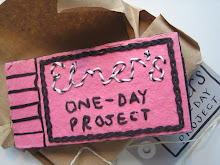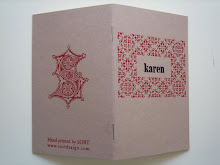28.3.10
The Properties of Paper
In my last two projects I've been working with all kinds of paper but I don't really know much about it, I mean about paper and its properties. So before embarking on the projects, I took some time out to get to know the page.
In both of my bookworks the materiality of the paper used plays a significant part in conveying the concept. The covers are either partly or fully made out of Rag Paper, which has a fabric-like quality. Rag Paper with a weight of 210 grams per square meter was chosen specifically for the front and back covers of Elmer’s One-Day Project. This is because of its strength, which makes for a sturdy cover and at the same time its malleability, which enables the cover to be embroidered with ease.
At 230 g/sm a heavier type of Rag Paper was used for the interior of the concertina, I PATCH, which not only holds up the folding-out structure but also achieves an interaction with the typewriter, for example, on close inspection Rag Paper, like fabric, has a woven quality and therefore a textured surface, a surface that is raised and dipped so that any text printed onto it undergoes ‘texturisation’ by either falling into the dips or sitting on the surface. Thus, the paper affects the outcome as it allows for the stamps of the typewriter to just kiss the surface rather than indent or engrave, the kiss sometimes leaves behind a bold letter and other times a fading outline. This points to the physicality of mark making and the bodily gestures made by the artist, again pointing to the concept of the book as a record of its own making.
The materiality of the page has been experimented further in Elmer’s One-Day Project with the inclusion of Lamali Paper, which consists of stencilled and painted prints. Therefore, unlike Rag Paper, the embossed patterns on Lamali provide a raised surface, which creates interesting results with the typewriter, as it cannot always mark these painted areas. On the other hand, Jari Paper and Nat Lokta Fibre, both at 25 grams per square meter, is semi-transparent as it is not made up of fabric but parts of cut-up thread pressed together. It is used in the same was as the plastic sheets of Hsia Yu's transparent poetry bookwork 'Pink Noise', to create a multi-layering of text. Its transparent quality means that any text typed on to the page is carried through to the page underneath. However, unlike printing onto plastic, the paper possesses its own texture and is further dented with the stamps of the typewriter.
I hope to start making my own paper soon.
22.3.10
Elmer's One-Day Project
Elmer’s One-Day Project is a 12 x 6 cm book consisting of 54 hand cut pages. It is a limited edition of 5. Each book is individually handmade and bound using Japanese Stab binding. The bookwork is made of offcuts of paper from previous projects, including the concertina I PATCH. The cover is made from Rag paper with embroidered text and a chain-stitch border. The text inside of the bookwork is typewritten. Elmer’s One-Day Project has been constructed to reveal the handmade and craft skills involved in its production.





I have used a variety of paper to sew or type through in order to present these materials performing together. They not only draw attention to themselves but also the process they have undergone. Consequently, they show “work” in performance. “Work” as in embroidering, binding, folding, ripping, patching and typewriting, where the holes, stitches and stamps of the typewriter possess a sense of immediacy, a sense of something being created and unique to a particular moment. I hope that each of these processes becomes a record of production.





I have used a variety of paper to sew or type through in order to present these materials performing together. They not only draw attention to themselves but also the process they have undergone. Consequently, they show “work” in performance. “Work” as in embroidering, binding, folding, ripping, patching and typewriting, where the holes, stitches and stamps of the typewriter possess a sense of immediacy, a sense of something being created and unique to a particular moment. I hope that each of these processes becomes a record of production.
Subscribe to:
Posts (Atom)




















